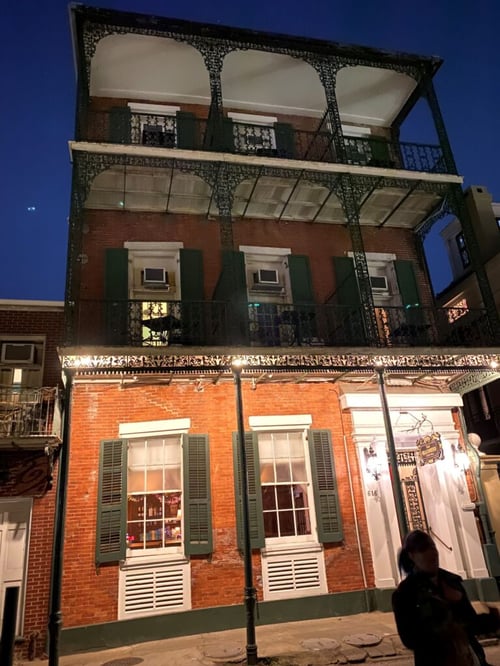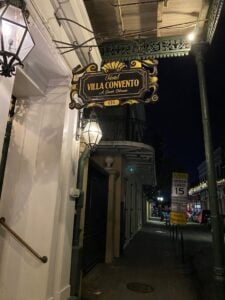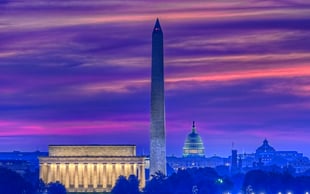Story Behind the Building-The House of the Rising Sun
There is a house in New Orleans.
No one is for certain it’s the Rising Sun, but it is one of the most rumored to be the inspiration behind The Animals rendition of the song, The House of the Rising Sun. With such a multitude of histories and a bawdy history at that, it is impossible to confirm that the three-story Creole townhouse that sits at 616 Ursulines Avenue in New Orleans, Louisiana is, in fact, the house of the rising sun, but it certainly has a reputation for sin and misery.
What is now the Hotel Villa Convento was built by Louise Forstall Poeyfarre, a widower, for her residence in 1833. Her husband, Jean Baptiste Poeyfarre purchased the land where the house sits from the Ursulines nuns—the first Roman Catholic nuns to come to the United States. From the building's balconies, you can see Old Ursuline Convent, which is the oldest structure in the Mississippi River Valley.
The building is a traditional Creole townhouse, built in the popular style at the time, with Greek Revival accents like the friezes above the doors. Common to the Creole townhouse architecture, it has a timber frame, masonry structure and sits flush to the sidewalk. It also has six-paned windows, marble steps, square columns, and decorative cast iron—a more upscale touch than would have been regularly seen on Creole townhouses then.
Are you a fan of architecture? Read more about the legendary Bruce Goff in this article.
Creole townhouses are seen all along the French Quarter. It is uncertain whether they are Spanish or French-influenced, but they are distinguished by their tall and narrow construction with a side-gabled or hipped roof and vertical massing. They are often L-shaped and have a carriage passage from the street to the courtyard on the side of the house. The beautiful garden courtyards in New Orleans today were originally used as a functional space for the kitchen, bathroom, stables, and slave quarters.
 The Hotel Villa Convento is a traditional Creole townhouse, built in the popular style at the time, with Greek Revival accents.
The Hotel Villa Convento is a traditional Creole townhouse, built in the popular style at the time, with Greek Revival accents.Throughout its earlier history, the house only changed owners four times, making it nearly possible to pin down when the house served as a brothel-or if it ever did. However, it is commonly believed that the house was known as a house of ill-repute right after the Civil War, where life in New Orleans had become “turbulent,” as described by Ghost City Tours. This would have most likely been the time when this type of (ahem) service was in great demand and would have brought easy money to the house’s owners during a period of serious depression in the South.
The hotel is a popular stop on most historical and ghost tours in New Orleans. Savannah, Georgia tour owner and guide, historian, and author James Caskey described it as one of the most haunted hotels in New Orleans.
Do you want to learn more about some of the country's most haunted buildings? Click here!
A tour guide on the Bad Bitches of New Orleans Ghost Tour tells the story of the madame at the brothel who didn’t tolerate “bad men.” When men visiting the brothel became unruly, the madame would have her ladies surround him, beat him, and then steal his money. Supposedly, the madame is still in residence at the Hotel Villa Convento keeping her eye on things and still making sure the men staying at the hotel know she’s watching.
 Guests report hearing phantom knocks on their doors (a sign from the madame to “wrap things up”), laughter and noises coming from empty rooms, men report hearing their names whispered in their ear, and both men and women guests have reported seeing apparitions—especially one of a woman wearing all black watching them sleep from a corner in the room.
Guests report hearing phantom knocks on their doors (a sign from the madame to “wrap things up”), laughter and noises coming from empty rooms, men report hearing their names whispered in their ear, and both men and women guests have reported seeing apparitions—especially one of a woman wearing all black watching them sleep from a corner in the room.
It is even said that if you aren’t sure your man is a keeper, you can stay in the Hotel Villa Convento and the madame will let you know if he is a bad seed.
The property was purchased in 1902 by Pasquale Taromina where he resided with his family until 1946 when it was sold and converted to a rooming house. During this time, it was called Old Town Villa, where it's known that Jimmy Buffet spent time staying (in room 305 for you Parrot Heads.) In the early 1970s, the building turned into the Hotel Villa Convento. It is now owned by the Campo family.
If you like this story, we know you'll like this one. Click here!
Now, as far as the hotel being THE House of the Rising Sun, there are many theories. The song could be referring to any brothel, as “house of the rising sun” is used as a euphemism for brothels. It could be referring to a jail when interpreting the lyrics but there are also historical documents showing proof of buildings in New Orleans called “Rising Sun.”
In the 1820s, before it burned, there was a hotel called the Rising Sun located on Conti Street in the French Quarter. In the late 19th Century, a social club called the Rising Sun Hall was located on the riverfront on Cherokee Street. Some claim it was a brothel located on Esplanade from 1862 to 1874 whose madame’s name, Marianne LeSoleil Levant means “rising sun” in French. And even further, there was a coffee shop/bar/restaurant on Decatur Street in the 1860s called The Rising Sun.
The first known collection of the song The House of the Rising Sun is from Appalachia in the 1930s—then most likely known as Rising Sun Blues. The Animals began ending their live shows with the song when they were on tour with Chuck Berry in 1964. They recorded the song in one take in a small studio in London on May 18, 1964. The song reached the top of both the U.S. and UK pop charts quickly after its release. Many other artists have recorded the song—Woody Guthrie, Bob Dylan, Nina Simone, Joan Baez, and Dolly Parton to name a few.
The song is about “someone’s life gone wrong” in New Orleans. Through the 1800s, New Orleans saw an influx of immigrants. By 1810, New Orleans was the fifth largest city in the country with one of the country’s busiest ports. With many sailors docking there and little opportunity for the poor and newly immigrated, many women turned to prostitution. The city of New Orleans even legalized prostitution in one area of town right outside the French Quarter—Storyville. Professor Judith Kelleher Schafer who wrote about prostitution in Antebellum New Orleans describes the city as “wild” then. Undoubtedly, there were plenty of opportunities for a poor boy to find ruin in NOLA. So, whether a jail, a bar, a brothel, or as a symbol for the city itself, any of the theories could be correct.

-1.png?width=112&height=112&name=image%20(4)-1.png)














